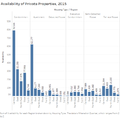IS428 2016-17 Term1 Assign1 Bong Jun Hao
Contents
Abstract
This project aims to look at the private property outlook in Singapore, using data of private properties in 2015 extracted from the URA's REALIS database. It focuses on 2 aspects, the supply of private properties as well as their prices.
Problem and Motivation
With the Population White Paper released in 2013 by the Singapore Government projecting Singapore's population as 6.9 million in 2020, there is an underlying meaning with this projection as it seems to indicate that there would be an influx of foreign talents to support and reach this projected population since our birth rate at 1.25 in 2015 is not enough to replenish our own population; let alone increase it.
The housing policy in Singapore is such that the foreign talents or expats are not allowed to purchase public housing, and as such their choices are limited to that of private properties.This leads to increased competition for private housing in Singapore, as increasingly affluent citizens looking to upgrade from public housing or for investment purposes would also need to vie with non-citizens looking for a roof over their heads. On the other hand, the slowing of growth of expatriates coming into Singapore has also led to fluctuations in demand and supply of private properties, perhaps slightly contributing to a fall of 3.7% in its price in 2015. These fluctuations give rise to a potential opportunity for other potential homeowners to move in, be it for investment or otherwise.
Hence the motivation behind this project lies in exploring the distribution and availability of private properties in Singapore as well as its price levels, so as to help potential buyers in making a decision when it comes to buying private properties. The main variables involved in this would be firstly the number of available private housing and secondly, the pricing of such housing. All these takes in to account the distribution of such housing by types across the different regions in the country.
Approaches
Prior to examining and analyzing the data, the first step would be to collate the data set, and this involves going into the Urban Redevelopment Authority(URA)'s REALIS database to extract data regarding private property in Singapore. I focused solely on the private residential properties in Singapore, choosing to draw out data using the Stock and Transactions tab as they allow me to retrieve information regarding the availability as well as the transaction prices of private properties in 2015.
When using the stock and transactions tab i made use of the data analysis tool in REALIS to make use of filters or variables such as the planning region (Central, East, North East, North, West) which would help when using the Tableau tool to differentiate the private properties distribution and pricing by geographical segmentation.
Data Cleanup
The data retrieved from the REALIS database is not in a format that is suitable for use with the Tableau software for analysis. Difficulties were encountered when trying to use the data in its raw format as there were cases where there were null entries, such as when retrieving the transaction information in 2015 since there were some months where a particular type of private property did not have any sales or change of ownership. In other cases, there is a need to arrange the heading of the data better so that it can be easily manipulated into the rows and columns when using the Tableau software.
As such, there is a need to manually download and manipulate them into a format such that it can be fed into the Tableau software for easier management.



